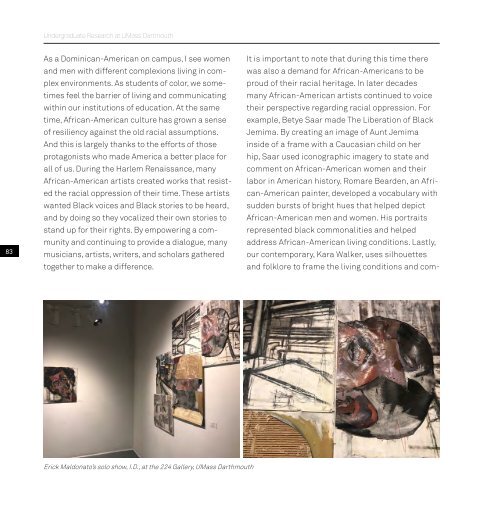Undergrad_Book_16-18_Pge_View_Print_no print marks_compressed
Create successful ePaper yourself
Turn your PDF publications into a flip-book with our unique Google optimized e-Paper software.
<strong>Undergrad</strong>uate Research at UMass Dartmouth<br />
83<br />
As a Dominican-American on campus, I see women<br />
and men with different complexions living in complex<br />
environments. As students of color, we sometimes<br />
feel the barrier of living and communicating<br />
within our institutions of education. At the same<br />
time, African-American culture has grown a sense<br />
of resiliency against the old racial assumptions.<br />
And this is largely thanks to the efforts of those<br />
protagonists who made America a better place for<br />
all of us. During the Harlem Renaissance, many<br />
African-American artists created works that resisted<br />
the racial oppression of their time. These artists<br />
wanted Black voices and Black stories to be heard,<br />
and by doing so they vocalized their own stories to<br />
stand up for their rights. By empowering a community<br />
and continuing to provide a dialogue, many<br />
musicians, artists, writers, and scholars gathered<br />
together to make a difference.<br />
It is important to <strong>no</strong>te that during this time there<br />
was also a demand for African-Americans to be<br />
proud of their racial heritage. In later decades<br />
many African-American artists continued to voice<br />
their perspective regarding racial oppression. For<br />
example, Betye Saar made The Liberation of Black<br />
Jemima. By creating an image of Aunt Jemima<br />
inside of a frame with a Caucasian child on her<br />
hip, Saar used ico<strong>no</strong>graphic imagery to state and<br />
comment on African-American women and their<br />
labor in American history. Romare Bearden, an African-American<br />
painter, developed a vocabulary with<br />
sudden bursts of bright hues that helped depict<br />
African-American men and women. His portraits<br />
represented black commonalities and helped<br />
address African-American living conditions. Lastly,<br />
our contemporary, Kara Walker, uses silhouettes<br />
and folklore to frame the living conditions and com-<br />
Erick Maldonato’s solo show, I.D., at the 224 Gallery, UMass Darthmouth



